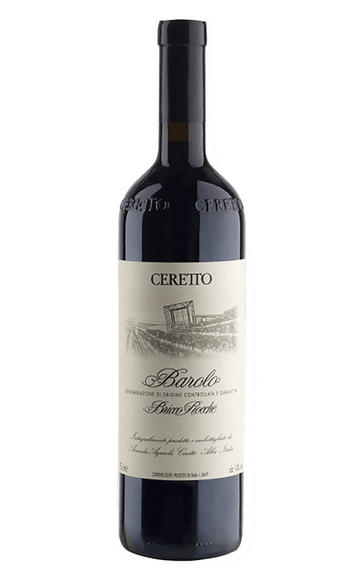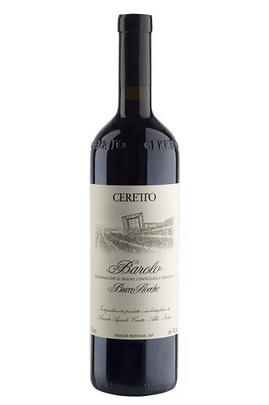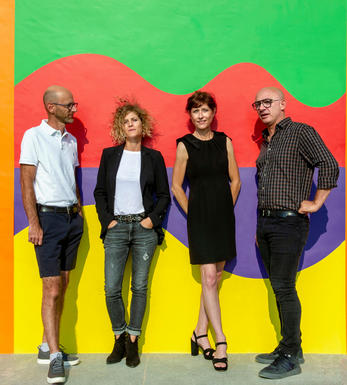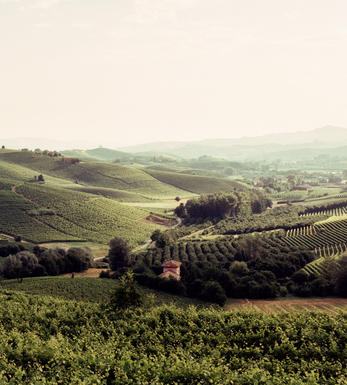
2019 Barolo, Bricco Rocche, Ceretto, Piedmont, Italy

Critics reviews
Drink 2029-2044
Antonio Galloni, vinous.com (November 2022)
Drink 2024-2038
Walter Speller, jancisrobinson.com (November 2022)
The Ceretto 2019 Barolo Bricco Rocche is made with organic fruit from Castiglione Falletto, one of the villages that performs best, generally speaking, and specifically in this classic vintage. The bouquet is layered and rich with ripe cherry and crème de cassis. There are savory tones of iron ore and grilled herb. It offers a silky mouthfeel with elegant mineral nuances. Overall, this wine shows impeccable precision and beautiful definition. This is one for your cellar.
Drink 2025-2048
Monica Larner, Wine Advocate (August 2023)
Lots of fresh roses and dried strawberries. Full-bodied and powerful with lots of tannins, yet they are fine and polished. Excellent length. A classic Barolo with the structure and beautiful freshness you expect for long term aging. Give it at least five to six years to come together. Try after 2028.
James Suckling, JamesSuckling.com (July 2023)
About this WINE

Ceretto
This family-run business was founded by Riccardo Ceretto in 1937, principally as a négociant in Alba. He was joined by his sons Bruno and Marcello in the 1960s. Wanting to make and sell their own wines, they began to buy premium land in Barolo and Barbaresco and were among the very first in the region to see the potential of single-vineyard wines. Bruno’s children, Federico and Roberta, and Marcello’s, Alessandro and Lisa, joined in the 1990s. After a period of change and experimentation, a particular style emerged in 2010, utilising shorter skin contact, and a mix of barrique and small botte for a supple but precise expression of Nebbiolo. The family are also involved in various artistic and heritage projects, including the rejuvenation of the famous Piedmontese hazelnuts and two restaurants in Alba: La Piola and the three-star Michelin Piazza Duomo.
In recent years, Ceretto’s winemaking style has been more relaxed, and it is interesting to see how this plays in a vintage like 2019. The 2018 wines were undeniably very successful, with the heady fruit of the year brilliantly captured and expressed. In 2019, that immediacy is more muted, but where Ceretto’s house style does succeed is in working finesse into the tannins. Many producers reported that their 2019s were slow to evolve once in barrel or bottle, and it was only towards the end of their time in wood that the quality of the vintage began to shine. That is not the case here. The purity and linear expression of the vintage has been in place for Ceretto’s wines right from the start. These are more intellectual wines than the 2018s, and their qualities are self-evident.

Barolo
Located due south of Alba and the River Tanaro, Barolo is Piedmont's most famous wine DOCG (Denominazione di Origine Controllata e Garantita), renowned for producing Italy's finest red wines from 100 percent Nebbiolo.
Its red wines were originally sweet, but in 1840 the then extant Italian monarchy, the House of Savoy, ordered them to be altered to a dry style. This project was realised by French oenologist Louis Oudart, whose experience with Pinot Noir had convinced him of Nebbiolo's potential. The Barolo appellation was formalised in 1966 at around 1,700 hectares – only a tenth of the size of Burgundy, but almost three times as big as neighbouring Barbaresco.
Upgraded to DOCG status in 1980, Barolo comprises two distinct soil types: the first is a Tortonian sandy marl that produces a more feminine style of wine and can be found in the villages of Barolo, La Morra, Cherasco, Verduno, Novello, Roddi and parts of Castiglione Falletto. The second is the older Helvetian sandstone clay that bestows the wines with a more muscular style. This can be found in Monforte d'Alba, Serralunga d'Alba, Diano d'Alba, Grinzane Cavour and the other parts of Castiglione Falletto. Made today from the Nebbiolo clones Lampia, Michet and Rosé, Barolo has an exceptional terroir with almost every village perched on its own hill. The climate is continental, with an extended summer and autumn enabling the fickle Nebbiolo to achieve perfect ripeness.
Inspired by the success of modernists such as Elio Altare, there has been pressure in recent years to reduce the ageing requirements for Barolo; this has mostly been driven by new producers to the region, often with no Piedmontese viticultural heritage and armed with their roto-fermenters and barriques, intent on making a fruitier, more modern style of wine.
This modern style arguably appeals more to the important American market and its scribes, but the traditionalists continue to argue in favour of making Barolo in the classic way. They make the wine in a mix of epoxy-lined cement or stainless-steel cuves, followed by extended ageing in 25-hectoliter Slavonian botte (barrels) to gently soften and integrate the tannins. However, even amongst the traditionalists there has been a move, since the mid-1990s, towards using physiologically (rather than polyphenolically) riper fruit, aided by global warming. Both modernist and traditional schools can produce exceptional or disappointing wines.
Recommended traditionalist producers:
Giacomo Borgogno, Giacomo Conterno, Bruno Giacosa, Elio Grasso, Marcarini, Bartolo Mascarello and Giuseppe Mascarello.
Recommended nmdernist producers:
Azelia, Aldo Conterno, Luciano Sandrone, Paolo Scavino and Roberto Voerzio

Nebbiolo
Nebbiolo is the grape behind the Barolo and Barbaresco wines and is hardly ever seen outside the confines of Piedmont. It takes its name from "nebbia" which is Italian for fog, a frequent phenomenon in the region.
A notoriously pernickety grape, it requires sheltered south-facing sites and performs best on the well-drained calcareous marls to the north and south of Alba in the DOCG zones of Barbaresco and Barolo.
Langhe Nebbiolo is effectively the ‘second wine’ of Piedmont’s great Barolo & Barbarescos. This DOC is the only way Langhe producers can declassify their Barolo or Barbaresco fruit or wines to make an early-drinking style. Unlike Nebbiolo d’Alba, Langhe Nebbiolo can be cut with 15% other red indigenous varieties, such as Barbera or Dolcetto.
Nebbiolo flowers early and ripens late, so a long hang time, producing high levels of sugar, acidity and tannins; the challenge being to harvest the fruit with these three elements ripe and in balance. The best Barolos and Barbarescos are perfumed with aromas of tar, rose, mint, chocolate, liquorice and truffles. They age brilliantly and the very best need ten years to show at their best.


Buying options
Add to wishlist
Description
Ceretto’s Barolo Bricco Rocche comes from a 1.5ha vineyard, the smallest defined MGA in Barolo, and a Ceretto monopole. “Bricco” is local dialect for the highest point or peak of a hill, and this striking vineyard lies in the heart of the Castiglione Falletto designation. Facing south-east, it adjoins the famous Villero, but is a cooler site than its neighbour. The wine has a lifted, cool perfume that carries all the way to the palate, where it delivers a deep and impressive focus. All of this is achieved with a welcoming, gentle gloss of ripeness. This is something rather special.
Drink 2027-2050
wine at a glance
Delivery and quality guarantee